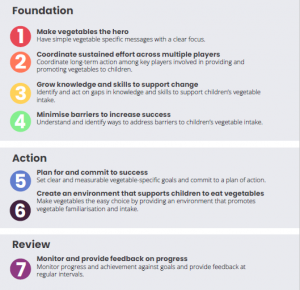Working together to boost children’s veg consumption
A $4 million, five-year national project is helping to address the significant underconsumption of vegetables by Australian children. This project is bringing together science and industry, with CSIRO, Flinders University and Nutrition Australia working together to deliver an integrated approach to improve these consumption figures through the education of children, training for educators and engagement with industry. Vegetables Australia reports.
Tools and interventions for increasing children’s vegetable knowledge – VegKIT (VG16064) is a strategic levy investment under the Hort Innovation Vegetable Fund, and its aim is clear: to increase the vegetable intake of Australian children.
Designed to provide a collection of practical tools, resources and interventions, the five-year project centres around six key activities to support children, educators, and health care professionals, and engage with industry.
“We are focusing on children because 95 per cent of children don’t eat the recommended intake of vegetables,” CSIRO Project Lead Dr David Cox said.
“Establishing a liking for vegetables in childhood will set up a life-long demand for vegetables. This project is about getting children to enjoy vegetables, using knowledge about the development of taste preferences, and then using this information to find practical ways of addressing the problem.
“VegKIT aims to increase children’s daily intake of vegetables by more than half a serving per day.”
The project is delivering six key activities:
- Best practice guidelines to increase vegetable intake in children.
- A national online registry of initiatives to increase vegetable intake.
- Development and coordination of the Vegetable Intake Strategic Alliance (VISA).
- Updated dietary advice for maternal, infant and early years, using evidence-based knowledge of flavour exposure and food preference development, to facilitate children’s vegetable intake.
- Initiatives in the community (for long day-care settings) to increase children’s vegetable intake.
- Supply chain initiatives (industry innovations and early primary school settings) to increase children’s vegetable intake.
A collaborative effort
The project is being delivered by CSIRO, Flinders University in South Australia, and Nutrition Australia Victoria Division along with vegetable industry partners Perfection Fresh and Tony and Mark’s, and a non-government organisation, Healthy Kids Association.
A Vegetable Intake Strategic Alliance (VISA) has been established to capture a wide range of stakeholders including the horticulture industry, state and federal departments, nutrition and health agencies, research organisations, retailers, early learning and parenting organisations and various non-government organisations.
“VISA is working to leverage knowledge, funding and collaboration to achieve a shared vision of increased vegetable consumption among children and their families,” Dr Cox said.
“The intended outcome of VISA is to facilitate and inform future development and implementation of evidence-based initiatives that create long-term and sustained increases in children’s vegetable consumption.”
Veg guidelines
The VegKIT project has seven guidelines, which are grouped into three segments (see Figure 1). Dr Cox explained why these were developed by the project team.
“Despite a range of initiatives and programs that aim to improve children’s diet quality, few are effective in substantially increasing vegetable consumption long-term. Therefore, children’s intake of vegetables remains below the recommended level for good health and well-being,” he said.
“We developed a set of updated best practice guidelines using the latest scientific literature and are currently turning these into strategies for implementation by different stakeholders.”
To date, the project has created user guides for specific intervention to increase vegetable consumption, from long day care to primary school and out-of-school care.
“In this project we wanted to focus on places where children spend their time; on people who directly impact children’s vegetable intake through food provision; and on education environments,” Dr Cox said.
“We also wanted to focus on academic and policy makers who design programs to promote vegetables. All of these groups have an important role to play in increasing Australian children’s vegetable intake.”
Identifying barriers
The project has revealed that telling children to eat their vegetables for health or trying to bribe them will discourage consumption.
“We have recognised that kids eat what they like and that vegetables are a challenge, because they are not innately liked. But children can learn to like them if they are made available, on a regular basis, in a wide range of eating occasions and settings,” Dr Cox said.
“So, we are focusing on food preference development and the sensory qualities of vegetables and evidence-based behavioural techniques; for example, making vegetables available as an easy choice. We know that childcare doesn’t always find it easy to make vegetables available, so we are partnering with a supplier to make this easier in long day care and teach kids about veg.
“We also know that very few vegetables are currently provided in primary school canteens, so we have identified ways of adding vegetables to offerings.
“Children like certain qualities of foods (e.g. sweetness) so we have used that knowledge to develop new product concepts more suitable for children.”
It has also been found that engaging with families to increase children’s vegetable consumption is important.
“We are working through settings where children eat and learn, and away from the possible battlefield that is the family meal,” Dr Cox said.
“We are supporting families indirectly by teaching kids to like vegetables while they are at childcare or at school. The aim is that they will take these new food preferences home with them.”
There has also been collated evidence on flavour transfer through the womb and breastfeeding that may pre-dispose infants to like the flavours of vegetables.
“We have identified that repeated exposure at weaning, particularly to a variety of vegetables, will teach infants to like the flavour of vegetables. We are currently assessing the strength of this evidence to see if dietary advice to parents can be refined to be more vegetable orientated,” Dr Cox explained.
Through the VegKIT’s ‘resource registry’, the project team is facilitating information sharing and best practice for encouraging vegetable consumption across a wide range of settings, including community initiatives. This can be found on the VegKIT website.
Further activities
The VegKIT website has recently been refreshed to provide resources by settings and sectors, including for growers.
“The resources will be promoted though engagement activities with each setting and, in that respect, growers can help promote what we have through their professional and personal networks, for example, asking if your child’s school or childcare is teaching about and providing vegetables,” Dr Cox said.
“We hope that the recently formed Fruit and Vegetable Consortium (FVC) will also provide an avenue for promoting behavioural-based changes and we will be working as a partner in the FVC.
“Our long-term aim is to raise consumption by half a serving and we will need a sustained effort over many years to make such a change, requiring all stakeholders, including growers, to continue with this effort.”
The bottom line
VegKIT has brought together stakeholders that work together to increase the demand for vegetables, in an age when demand for vegetables by children is static or possibly declining.
“The importance of turning this around cannot be stressed enough as it has enormous implications for the industry and public health outcomes,” Dr Cox said.
“There is potential to increase demand for fresh produce by 19,000 tonnes per year if every child (aged 2-6 years) increases consumption by greater than half a serving – demonstrating a great return on research investment.”

Planning for the VegKIT project
The current VegKIT activities had development phases that first created a strategic plan (A Strategy to Address Consumption of Vegetables in Children; VG13090) and then an implementation plan (Implementation Plan for Increasing Children’s Vegetable Intake; VG15005). Both projects were strategic levy investments under the Hort Innovation Vegetable Fund.
“By reviewing the evidence and involving a broad range of stakeholders, including an early iteration of the Vegetable Intake Strategic Alliance, we have focused upon what is likely to be the most effective activities involving many skills across a range of stakeholders,” Dr Cox said.
Other R&D projects
The project team is also leveraging from other vegetable levy investments. One is Educational opportunities around perceptions of, and aversions to, vegetables through digital media (VG16018), led by chef and media personality Alice Zaslavsky. Alice has featured in a VegKIT video discussing best practice for long day care providers.
Another is Development of a vegetable education resource – stage 2 (VG15067). Through this project, a primary school curriculum aligned sensory education resource for teachers is being rolled out as ‘Taste & Learn’. This will be adapted for use in long day care settings for younger children. More can be found here.
Find out more
Please contact Dr David Cox at david.cox@csiro.au or visit the VegKIT website.
This project has been funded by Hort Innovation using the vegetable research and development levy and contributions from the Australian Government.
Project Number: VG16064
This article features in the spring 2020 edition of Vegetables Australia. Click here to read the full publication.

